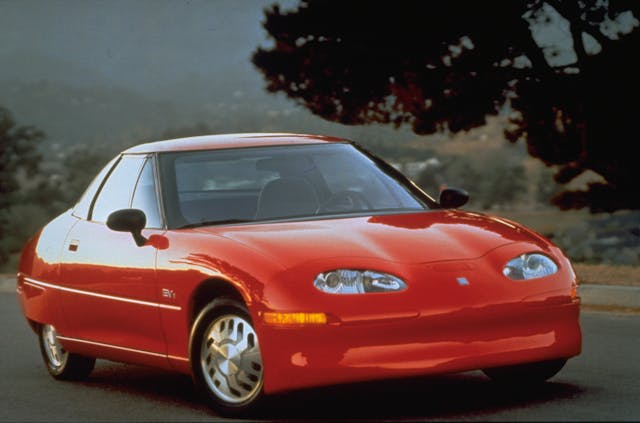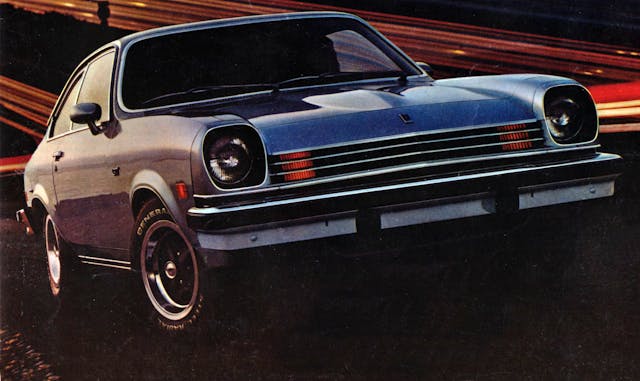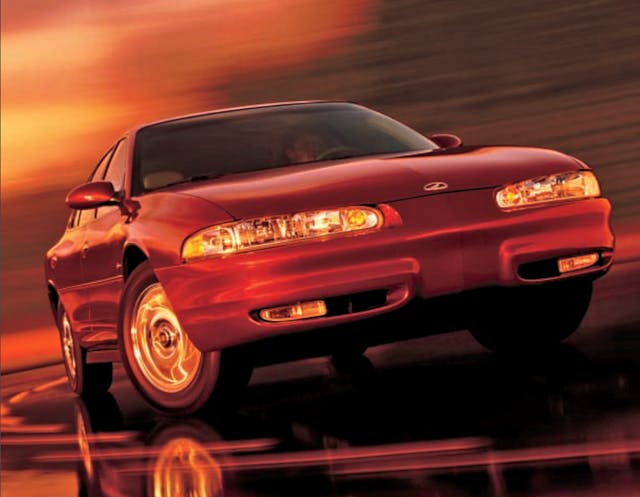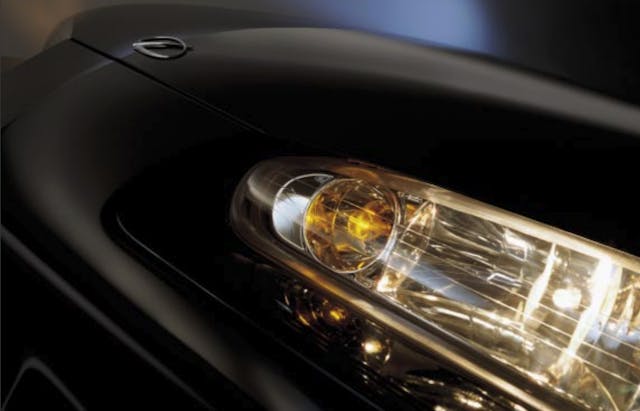Media | Articles
9 tragically flawed GM vehicles whose heroic fixes came too late
Decades upon decades passed when General Motors could do no wrong, and the products rolling off its assembly line were proof positive of its business model’s supremacy. But nobody’s perfect, and mistakes had to be addressed to meet stockholder’s expectations. GM’s design and engineering teams made some great cars with serious potential that were packed with tragic flaws—and received heroic fixes that came right before their curtain calls. It’s all rather tragic, so here are nine examples to prove the point.
1993 Cadillac Allanté (Northstar)

You gotta give General Motors credit, because when it aims for the stars, it grabs a firehose full of ideas and shoots skyward. Take a shortened E-body coupe and turn it into a bespoke V-body, then deliver finished shells from Italy’s Pininfarina to Hamtramck via a convoy of Boeing 747s known as the “Air Bridge.” One of the biggest keys to the Allanté’s failure was the drivetrain layout (front-wheel drive does not a Mercedes SL competitor make) and the mediocre performance of Cadillac’s High Technology V-8 engines.
The lack of power was finally addressed in 1993, the Allanté’s final year, by the rocket-like thrust of Cadillac’s all-new Northstar V-8. The added grunt was competitive, but 1993 also included a heavily revised rear suspension, active dampers, and revised power-steering. As we previously mentioned, the 1993 Allanté was “finally, the internationally competitive luxury roadster its creators had envisioned … albeit six years too late.”
1988 Pontiac Fiero

One of the big problems with the Pontiac Fiero, aside from the engine fires of the early models, was the promise of sporty performance, which wasn’t realized until the last year of production. As we previously mentioned, cost-cutting sealed the Fiero’s fate well before 1988. There was simply too much parts-bin engineering: The compact X-body (Citation) front suspension was flipped 180 degrees and dropped in the back, while the front suspension was lifted from the T-body subcompact (Chevette). It’s a shame that in the Fiero’s final year the necessary suspension upgrades (new front control arms, knuckles, and an all-new tri-link rear suspension, plus a wider front track and, on WS6 models, staggered wheels) and improved brakes (four wheel vented discs) couldn’t alter the course of history. These bits were precisely what Pontiac engineers intended for the Fiero from the get-go. At least we got one year of mid-engine Pontiac Excitement.
2020 Cadillac CT6-V (Blackwing)

Hate to say it, but the Cadillac CT6 is not unlike the Cimarron before it. That’s because the last examples of Cadillac’s J-body experiment indeed improved when a 2.8-liter V-6 and five-speed manual transmission were standard equipment. Similarly, the CT6 never set the world on fire, because a flagship luxury sedan needs more swagger under the hood than a turbocharged four-cylinder could ever provide. (Yes, the CT6’s standard engine was 0.8 liters smaller than what’s on tap for a 1987 Cimarron.)
Marketplace
Buy and sell classics with confidence
The CT6 didn’t receive a proper V-8 until the 2020 CT6-V hit the scene with the similarly star-crossed Blackwing motor. Because there is still a market for upper-crust luxury sedans (think Mercedes S-Class), the CT6 deserved an optional V-8 from the start. What happened when the CT6 got it all? Both the engine and the car unceremoniously met their maker.
1917–18 Chevrolet Series D

The Series D was truly a car ahead of its time, sporting a standard overhead-valve V-8 engine that came a full 38 years before the famous small-block Chevrolet V-8. A gentleman named A.T. Stuart designed a surprisingly lightweight chassis and a rear suspension with quarter-elliptic rear leaf springs mounted in a rather radical cantilever fashion. All of which should have meant a longer production run for the Series D, so what happened? General Motors happened. It’s a safe bet that the 1917 integration of Chevrolet into General Motors ensured the premium Chevrolet V-8 could never be a threat to offerings from Oldsmobile and Buick.
General Motors EV1 (NiMH upgrade)

This one is a no-brainer: Have a look at the photo that comes with the Wikipedia definition of compliance car. The EV1 was ahead of its time and yet destined for failure. We’ve discussed the truth about this car previously, but the fact remains: The EV1 only improved toward the end, when the second generation received nickel-metal hydride (NiMH) batteries. While NiMH aren’t nearly as good as the li-ion batteries that made Tesla famous, the EV1 proves that General Motors was dead-serious about electric propulsion. And it doubled down on its efforts by improving the EV1 … before they crushed (almost) all of them.
1929–31 Viking

Based on one of GM’s first shared platforms (the ubiquitous 1926–96 GM B-platform), the Viking by Oldsmobile was a short-lived experiment in premium branding for an established automaker. While this notion was successful for Oakland (i.e. Pontiac) it didn’t work out here, or at Buick (with Marquette), or at Cadillac (with LaSalle). Well, perhaps it worked a little too well for Oakland. No matter, Viking was “built to meet growing public demand for an eight-cylinder car of General Motors quality at medium price.” Talk about irony: The Series D mentioned above was doing the same for Chevrolet a little over a decade before. GM knows market segmentation can only take it so far, but market research in the Herbert Hoover era was probably lacking a bit.
2006 Chevrolet SSR (LS2)

Chevrolet’s Super Sport Roadster was a truck with a folding hardtop, styled to be a hot take on the “Advance Design” pickups from 1947. The look was great, but it rested atop a revised GMT-360 platform (shared with the Trailblazer SUV) with a workhorse 5.3-liter V-8 (300 horsepower) that ensured the SSR didn’t perform as well as some hoped.
The combination of brilliant style atop mundane underpinnings is not unlike the Pontiac Fiero’s tragic tale, as looks weren’t enough to keep questions about SSR’s longevity at bay. The asking price was steep and sales were disappointing, but the penultimate year (2005) saw the introduction of the LS2 small block V-8 (390 horsepower) and an optional six-speed manual transmission. Could this be the reincarnation of the El Camino SS? Unfortunately not, as only 826 units were sold in 2006, even with a modest power bump (+5 for autoboxes and +10 for manuals). Perhaps the future coulda been brighter if the combination of LS2 LS6 and manual transmission was available from the get-go … or perhaps power was never the SSR’s problem.
1976–77 Chevrolet Vega

I come not to bury the Chevrolet Vega, but to praise it. The early models certainly had their problems, but like most American cars in the 1970s, a cornucopia of running changes happened behind the scenes and never got the attention they deserved. This isn’t just about big bumpers and catalytic converters, as there were presumably 264 changes in 1975 and 300 changes the year after. Our nation’s Bicentennial anniversary ushered in an honest-to-goodness five-speed manual transmission, corrosion-fighting improvements, cooling upgrades, revised chassis, larger brakes, and an upgraded rear suspension. The Vega’s final year (1977) was cleaner thanks to a revised secondary air-injection system, and the insides looked more upscale with color keyed steering wheels, steering columns, and a color-matched full console. While the Vega lived a long life (and spawned the sporty Monza/Skyhawk/Starfire/Sunbird) it’s safe to say that many of the best Vegas ever made were the last ones.
2002 Oldsmobile Intrigue

I’ll let you in on a little secret: General Motors’ long running W-body platform is rather underrated, and the best of the breed came from Oldsmobile. No other W-body has the clean, modern styling and sweated the details quite like the Intrigue. No really: I mean, just look real close at that nose!

While there was nothing particularly wrong with the Intrigue, unlike other Oldsmobiles that benefited from performance upgrades (think supercharged 3800 engines), the Intrigue died three years before the wicked 5.3-liter V-8 engine (LS4) was shoehorned into the W-body Pontiac Grand Prix GXP. If only the Intrigue GLS could have the LS4 V8 tearing up the streets, violently torque-steering its owners off the road with just a touch of the traction control button and a punch to the gas pedal. Iron fist, meet velvet glove: If only the Oldsmobile division survived long enough to make this happen!






Corvair – yes the poor man’s Porsche Veca – prettier and more modern than a Pinto My brand new one rusted through the top of the front fender in 7 months QUALITY. Finally, the final GTO went the first 2 years before Pontiac discovered that EVERY single GTO differed from a Tempest because of hood scoops. even the ’64 had them. How do the designers not understand style clues?
George the reason the 04 did not have hood scoops or a split exhaust was due to no money. GM was broke and Lutz had to use the Holden and convert it to American spec with money taken from other programs. I personally spoke to Fred Simmons of Pontiac Motorsport on this personally. He said give me the money and we will have them.
Note to fix the fuel system GM put the tank in the trunks that way they did not have to redesign the car.
Like I said in my post all these stories need context added as everything has a reason.
I think the Buick Reatta would have sold more if they would have built the turbo one they were testing.
GM bean counters rang the hammer of doom on many of his entries. How about the OHC Poncho 6…? Plastic parts before they were common…aka timing gears? The Corvair could of been a legendary machine , but by the time it was killed off and demonized by Nader it was too late for the Phoenix to rise. RIP Ernie Kovacs My aunt had to get the general to by back her 69 as it literally fell apart in the front drive. I have a friend who has 3 Reattas. Not too shabby !
Let’s put some of this in context. You need to know more than the passing story to understand more on these models.
#1 the Allante The cold hard unwashed truth is this. It was front wheel drive and never should have been front wheel drive. Adding the NorthStar fixed little here as it was still fwd. maybe adapting AWD but this car was never fixed.
#2 Fiero Here we go again. Yes the Fiero was never a perfect car. Few sports cars at this price ever are.
The Suspension was there at the start but no money. The suspension they used was not perfect but far from horrible. Yes the steering was heavy but removing the damper fixed this. Second the rear had some bump steer on bumpy roads.
These cars can be driven very sportingly and with a few upgrades to the rear control arm bushings harder bushings and a rear sway bar it is right there with the 88 suspension. I have a number of miles in both and know it is an easy fix.
The car died for political reason that are never discussed in GM sponsored books. Too much URW and division hate there.
Note the engine and suspension was also used in the Celebrity and 6000. It was not turned 180 degrees. It was just moved back. No turning so you may want to correct the story.
EV1. Now remember this, the car was not intended to be a full production car. It was more proof of concept and lived as long as intended. The cost was still too high and the technology just was not there. This was kind of like the Chrysler Turbines where it was a peek at the future but not for sale. The car did its job and we should not have expected anymore.
The SSR This was a Hail Mary by Lutz to keep excitement up at a company that was going down by the bow. He had little money and little to work with so they build a show car on a Trailblazer frame.
Yes it was over priced and the truck was too much snow car not enough production car. Ergonomics were horrible. To adjust the seats you had to open the doors. The Chassis was not stiff with the bed and folding top. I autocross one and the chassis wiggled all over. Again this was not a long term model and it is not likely it could have been priced cheaper at low volume. No fix here.
Vega. It just needed rust prevention and iron cylinder liners. It really was not a bad car but cutting corners made it bad. You can say what you like. We used Vegas for winter beaters in high school. Yes they used oil and were not pretty but they always started and ran no matter how cold. We dumped used oil in as it would burn anyways. One of ours got sent to the junk yard twice and still came back for two more winters.
Hmm the CT6 Well nothing was wrong with the car it was GM and Cadillac. Cadillac was on the way with some very good product when GM pulled the rug out and made the decision to go electric. The gentleman from Audi that was fixing things left. So the V8 came out. But lived a short life. This was a Case where GM since 1985 has had no clue what to do with Cadillac. It is not just GM as Ford is doing worse to Lincoln.
The Olds W body. What killed Olds was generic FWD cars. Pontiac was the division expected to die but killing the Cutlass Supreme RWD set the path for Olds to die first.
While the W body was not bad it was just another soul less FWD.
The 3800 SC was good but there was no need for the V8. Nose heavy and with programming set to keep from killing the 4 speed transmission it was no where as fast as it should have been. The W body was just a GM car you picked the styling on. They really were not a Pontiac, Olds or Buick anymore, just generic corporate platforms.
The move to all FWD in the 80’s was a major mistake.
The two older are here. The Chevy nice but Henry owned the market on price.
The Viking. GM had too many divisions later and at that time it was too many divisions then.
As for the Corvair. #1 it died because of the Mustang.
Yes Ralph made things difficult but it was Ford that killed the car. The Corvair was not cheap to build with the flat 6 and trans axle once GM dropped it in the other models like the Tempest.
GM moved to the Camaro as it could build it and drop in a 327 and it was cheaper to build and more profitable.
Also the Corvair lived till 69 and Emissions killed it in the end. Same for the Bug as air cooled engine had poor emissions.
The Reatta was a cool car but again front wheel drive was the undoing.
Imagine a Reatta with RWD and a GN turbo?
Also the dash was a electrical issue as they had problems. GM often introduced new tech before it really was ready for the market. Today to restore one is a nightmare f the dash is failed.
As the proud former owner of a two owner 1985 Fiero that rolled 225,000+ miles before being killed by a Ford Festieva being planted into the back of it I will say that there was nothing wrong with the Fiero from day one. The buying public who wanted a Corvette with a Chevette price tag were the problem. The Fiero provided a sporty looking platform, reasonable handling, and adequate power to get you to and from the job you were working to pay for it, along with the fuel economy and a low enough payment to have enough left over to afford to go on dates in it, all while looking plenty good doing it. It could also spin the tires, and get sideways if pushed hard enough. That car was plenty of fun.
Great comment
I once owned a 1973 Chevy Vega GT. I thought it was a nice looking car, sort of a poor man’s Camaro. The overhead cam four was really weak and burned oil from day one. I always wanted to drop a smallblock V8 into it. By the time I had the funds to do an engine swap, the car’s body had turned to swiss cheese due to its total lack of rust resistance. I sold the Vega and bought a Chevy Cavalier, which turned out to be yet another under-powered, rust prone oil leaking lemon. Fool me once, shame on GM. Fool me twice, shame on me.
The Allante if it had a RWD second generation car could have bene something, the CT6 Blackwing V Motor looked to be great but saw limited use so most of us will never know how good it could have been and the Fiero killed just as the bugs were fixed and the suspension was improved. Fiero’s story sounds familiar to the Solstice/Sky twins which had a decent start only to never get a next generation car. It could have been a faster Miata competitor.
I really liked the Fiero and owned three of them back in the day. All the problems and some that were little known I have dealt with. The potential this car had bothers me to this day. Many people have posted in previous reads about the need for a car like this now, with all the things we know worked through and improved upon. Small, sleek, efficient (45+mpg), maybe electric? Did I say small? small/ small=. As in, we need more of in the U.S.A.
Fuel economy was always poor. Finely tuned I could get 18 mpg but the smog controls were never perfect and would cause the engine to run rich. The EGR valve has a paper gasket that would fail and leak, kicking the rich mode and 14 mpg.
My understanding of why GM killed the Fiero was that it took sales away from the Corvette. However, here I read of UAW problems yet I don’t know why Union problems would lead to the demise of a car like the Fiero.
We had the 99 Intrigue GLS with the LX5 DOHC 3.5L V6. The 3800 had better low end torque, and was more drivable, but get that LX5 up in the revs and it really came alive. Unfortunately it was costly to manufacture, and more and more of the top trip Intrigues got the 3800 as time went on. But that was a fun car to drive hard
I worked at PMD, Los Angeles Zone, when the Fiero was introduced. We knew from the very beginning that the Corporation was against funding the car. In spite of this, PMD designed and introduced the car on a sparse budget by using GM parts already in production. There were issues with the car from day one. Fiero sales were strong in CA, but not so much elsewhere. The Fiero was starved to death financially as was the division in later years.
You are correct on the funding.
And I too put some blame on Pontiac for taking some high risks. The car was over sold the first couple years to justify the plant in Pontiac MI. It was good for 250k units per year. The problem is 2 seat cars are a limited market.
Pontiacs plan was yo put the GM80 in the same plant. But it was canceled. It was rge FWD F body replacement. Once it was canceled it gave the Corvette group and Chevy the ammunition to kill the car.
This risk Pontiac list.
As for sales the Fiero best market was the Midwest. Ohio. Michigan, Illinois, Indiana, Pennsylvania we’re the strongest areas. Even today the largest Fiero clubs are located in these areas.
I had the opportunity to drive an early Vega and did not buy it, but my neighbor bought one of the last ones, and it was a blast to drive. If you like the styling as much as I do find a late model car and buy it. You won’t regret it.
I’ve also had some Northstar engines in Cadillacs, and I never had any trouble with them.
Did not see any negative comments on the SSR. Was always interested in them from the beginning and still am. Might still buy one. 5.3 is enough power for me.
Bring back the CT6!! Cadillac is still producing the CT6 in China and even makes a 120th Anniversary Edition. Albeit is not a Blackwing, it just does not make sense that they produce a 120th Anniversary Edition for a car company that was formed in Detroit and you can’t buy it here!!. My parents really want a new CT6 and do not need the V-Series but want the bigger car over a CT5 but may have to settle for a 5.
I kept looking for the 1979 Chevy Cheyanne pickup truck with diesel engine on that list. They took a standard 350 V8 out of the parts department and slapped diesel heads on it. Didn’t anyone question the fact that the compression more than doubled yet they used the same head bolt pattern from the standard gasoline powered V8? I blew head gaskets at 18,000 miles, just past the end of the warranty period. I asked Chevy dealership repair guy if that wasn’t kinda early to blow the head gaskets, and he told me I “got more miles than most before they blew”. Eventually there was a class action suit and I got my money back. A couple of years after I sold it to a guy that just had to have a diesel (yes he knew I fixed head gaskets) I saw him on the side of the road with the hood up looking at the engine. I haven’t bought a GM vehicle since then…maybe never will.